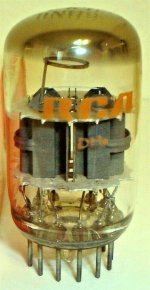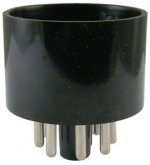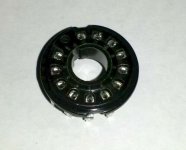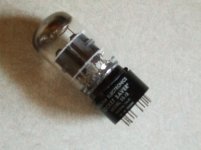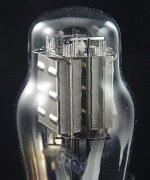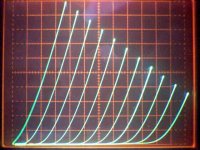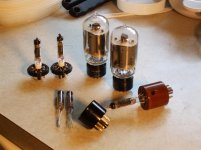Just curious, are/were there any low power dual pentodes in octal?
I know there are a few power tubes like 6DZ7 but I can't think of any low power ones.
I know there are a few power tubes like 6DZ7 but I can't think of any low power ones.
I haven't used it for a while but Duncan's TDSL has a parameter search that I recall finding pretty useful.
8-2 filament = 6 . What can you do with 6 pins ? For power tubes could be acceptable to share the cathode and G2
Last edited:
All those are "power" tubes for use in final stages , even if the output power is very weak.
I thought the question is for small signal tubes .
I thought the question is for small signal tubes .
Last edited:
9ma plate/anode --how low do you want to go ?--that's lower than many input triodes
It doesn't matter what it was used for output was 0.5w or less and it is what the OP asked for=="are/were there any low POWER dual pentodes in octal "
It doesn't matter what it was used for output was 0.5w or less and it is what the OP asked for=="are/were there any low POWER dual pentodes in octal "
It doesn't matter what it was used for output was 0.5w or less and it is what the OP asked for=="are/were there any low POWER dual pentodes in octal "
Well, let's not argue about what I said. I'll be happy to clarify.
Each tube (usually) has a description as to what the manufacturer designed it for. If that description includes "push pull output", then no, that's not what I'm interested in.
For Euro tubes, I'm interested in EFF, not ELL. So EFF51 would qualify but it's not octal. Another clue is that tubes not intended as output tubes do not have output power specified.
Mas preguntas?
Then the ones I posted have a common K and G2 --K=pin 2 + G2=pin 5.--26A7 and the 28D7 has also a common K + G2 .
What it was used for in the 1950,s was aircraft/mobile as they couldn't get the correct SS at that time, that doesn't disqualify it for use at a modern signal input .
I know very well the differences in tubes been working with them since the late 50,s.
What it was used for in the 1950,s was aircraft/mobile as they couldn't get the correct SS at that time, that doesn't disqualify it for use at a modern signal input .
I know very well the differences in tubes been working with them since the late 50,s.
Last edited:
Is a dual tetrode acceptable for your purpose?
What about the GU-17 aka QQE03/12 aka CV2798?
http://hamradio.online.ru/ftp/gu-17.pdf
What about the GU-17 aka QQE03/12 aka CV2798?
http://hamradio.online.ru/ftp/gu-17.pdf
12L8GT is a low power dual pentode with octal socket, which is exactly what you asked for. 2.5W plate dissipation per plate is about half of what a 6SN7 can take. It also draws about half the heater power compared to 6SN7. It seems "small signal" is a state-of-mind. Have a good day, sir.
DIY
or Fake it.
or Fake it.
Attachments
Last edited:
LOL, yes, make it or fake it.
It's interesting to look at some of the more unusual tube arrangements. While looking into this, I found 6BA11, a Compactron triode/dual pentode. The pentode part has each g3 brought out separate and not connected to k, but both g1 and g2 are common. Apparently that was useful for Sync/agc duty in tv service.
It's interesting to look at some of the more unusual tube arrangements. While looking into this, I found 6BA11, a Compactron triode/dual pentode. The pentode part has each g3 brought out separate and not connected to k, but both g1 and g2 are common. Apparently that was useful for Sync/agc duty in tv service.
That 6BA11 is one of those dual control split pentodes like 6BU8, 6KF8, 6MK8, 6GS8, 6HS8, 6LE8. G1 sets the overall current and the two g3's set the partitioning of the current between the plates. 6LE8 is a bigger version.
6BV11 is a dual dual-control pentode. 7AK7 and 6888 are Octal single versions. 9KC6 is a frame grid version. 6HZ6.... (can put +12V on the G3's to turn them into a nice ordinary pentode with sharp knees. )
The Beam Deflection tubes are a higher quality version of the dual control split pentodes. Can actually do multiplication functions with them. 6JH8, 6ME8, 6AR8, 6HW8, 7360
6BW11 gives you a dual dissimilar pentode. 6AU8 and 6EW6 similarity.
6BV11 is a dual dual-control pentode. 7AK7 and 6888 are Octal single versions. 9KC6 is a frame grid version. 6HZ6.... (can put +12V on the G3's to turn them into a nice ordinary pentode with sharp knees. )
The Beam Deflection tubes are a higher quality version of the dual control split pentodes. Can actually do multiplication functions with them. 6JH8, 6ME8, 6AR8, 6HW8, 7360
6BW11 gives you a dual dissimilar pentode. 6AU8 and 6EW6 similarity.
Last edited:
Very interesting. 2 pentodes in an octal package and an unused pin. That answers Depanatoru's question as to what you can do with 6 pins (plus 2 for filament).
My original question came about as I noticed that you can run a pentode LTP with common g2. I was looking at the schematic for the Citation II.
My original question came about as I noticed that you can run a pentode LTP with common g2. I was looking at the schematic for the Citation II.
Octal gone crazy.
Vector Octal to dual 9 pin adapter box. (some 6JC6A tubes or 6EW6 tubes maybe?)
Sub-Mini Octal 5639 pentodes (to be) wired to an Octal base. (suggest Augat 8 pin sockets up top in epoxy)
Augat "octal" Teflon 8 pin sockets on an Octal plug. (fits sub-minis or ICs)
CBS Octal ZIF adapter (for tube testers) - push wires in from two 5639 or 5902 ... pentodes as required. (wire insulation sleeves recommended)
Might as well make the whole -- Amp fake Octal,
Faux Octal 17KV6A output tubes with "Edison" seal tips.
With DIY adapters (N pin socket to Octal base) you could have adapters for plugging in a large range of output tubes into the Amp.
Vector Octal to dual 9 pin adapter box. (some 6JC6A tubes or 6EW6 tubes maybe?)
Sub-Mini Octal 5639 pentodes (to be) wired to an Octal base. (suggest Augat 8 pin sockets up top in epoxy)
Augat "octal" Teflon 8 pin sockets on an Octal plug. (fits sub-minis or ICs)
CBS Octal ZIF adapter (for tube testers) - push wires in from two 5639 or 5902 ... pentodes as required. (wire insulation sleeves recommended)
Might as well make the whole -- Amp fake Octal,
Faux Octal 17KV6A output tubes with "Edison" seal tips.
With DIY adapters (N pin socket to Octal base) you could have adapters for plugging in a large range of output tubes into the Amp.
Attachments
Last edited:
- Home
- Amplifiers
- Tubes / Valves
- Octal dual pentodes?
